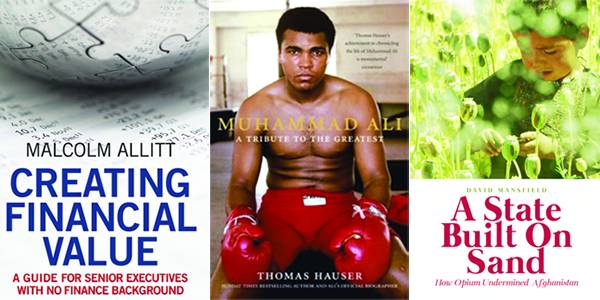
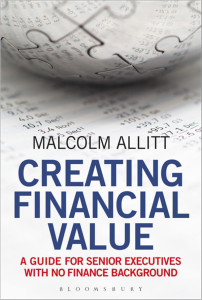
Creating Financial Value: A Guide for Senior Executives with no Finance Background
Malcolm Allitt
Bloomsbury (hardcover), 2016
PRs 1495
How many senior executives and managers are able to reach the top with little or no financial training? They may have been appointed to the executive board as a result of their expertise in marketing, HR, sales or IT, yet every board member has a responsibility to make informed decisions on proposed financial actions - decisions which inevitably affect the value of their business.
Offering straightforward and practical advice, Creating Financial Value will equip those who are not financial specialists with the necessary knowledge not only to contribute fully to important discussions on policy and strategy, but also to develop sound business proposals, or to competently cross-examine the proposals of others. Through examples from a range of business disciplines, the book explains in simple, digestible terms how a business creates financial value, and how a non-financial manager can confidently take an active role in the process. Once read, the book will provide an essential resource that can be referenced time and again.
Malcolm Allitt punctures the myths surrounding ‘shareholder value’ and looks behind the finance jargon to define the boundaries between what a non-specialist should know and when it is good practice to seek the advice of financial specialists. This book is key reading for anyone from a non-financial background who wants to execute their increasingly broad responsibilities competently and confidently, without the need to become experts themselves.
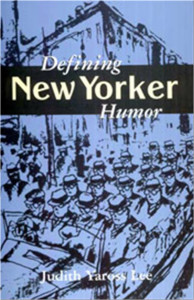
Defining New Yorker Humor
Judith Yarros Lee
University Press of Mississippi (paperback), 2000
PRs 2500
“The early history of New York is obscured in myth,” observed the pseudonymous author of “The Story of Manhattankind” in the first issue of The New Yorker (21 February 1925), “and to separate the purely historical from the purely hysterical is no easy task.”
The same must be said of the magazine itself. The purely historical remained hidden until The New Yorker’s archives were opened to scholars in the mid-nineties, although the hysterical—pure and otherwise—dominates the anecdotes in memoirs of some of the magazine’s original staff members.
Late in 1924 Harold Ross assembled a small staff to create a new kind of weekly humor magazine, a “reflection in word and picture of metropolitan life . . . with gaiety, wit, and satire.” His target audience was affluent, local, educated sophisticates. This is the image he sold to Manhattan advertisers. By 1930 the magazine could withstand the Depression even as its predecessors collapsed. In 1952 W. H. Auden declared The New Yorker “the best comic magazine in existence.” In 1994 no one disputed Tina Brown’s claim that its cartoons constitute “a sort of national treasure.”
Drawing on archival records and works by major contributors Judith Yaross Lee traces how artists, writers, and editors realized Ross’s vision. This first scholarly history of The New Yorker chronicles the magazine’s efforts to define an editorial formula that appealed to readers more interested in Picasso’s Paris than in Will Rogers’s Oklahoma. Lee recovers hundreds of still-funny cartoons, stories, and verses that were eclipsed because The New Yorker was not indexed and because its editors, until 1969, refused to include a table of contents. Also, she dispels cherished myths of the early years. Far from relying on a few insider wits, the editors scoured unsolicited submissions for new artists and writers, honing every item and inviting new ones. Misogynous in neither policy nor practice, the magazine cultivated women both as readers and contributors. While the beleaguered Little Man staggered through tales of the war between the sexes, equally discouraged women set their version of the battles into rhyme. Lee shows how The New Yorker’s eminence in cartoons blossomed as the captions were reduced to one line and as the subjects tweaked class and race prejudice, ridiculed feminism and modernism, lampooned urban customs and types, and created new relations between visual and verbal wit.
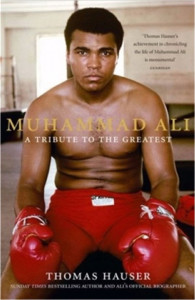
Muhammad Ali: A Tribute to the Greatest
Thomas Hauser
Harper Sport (paperback), 2016
PRs 895
Few global personalities have commanded an all-encompassing sporting and cultural audience like Muhammad Ali. Many have tried to interpret his impact and legacy into words. Now, Muhammad Ali: A Tribute to the Greatest allows us to more fully appreciate the truth?and understand both the man and the ways in which he helped recalibrate how the world perceives its transcendent figures.
In this celebratory volume, New York Times bestselling author Thomas Hauser provides a compelling retrospective of Ali’s life. relying on personal insights, interviews with close associates and other contemporaries, and memories gathered over the course of decades on the cutting edge of boxing journalism, Hauser explores Ali in colorful detail inside and outside the ring.
Muhammad Ali has attained mythical status. But in recent years, he has been subjected to an image makeover by corporate America as it seeks to homogenize the electrifying nature of his persona. Hauser argues that there has been a deliberate distortion of what Ali believed, said, and stood for, and that making Ali more presentable for advertising purposes by sanitizing his legacy is a disservice to history as well as to Ali himself.
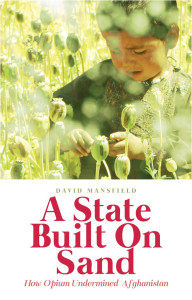
A State Built on Sand: How Opium Undermined Afghanistan
David Mansfield
Hurst (paperback), 2016
PRs 4495
Oscillations in opium poppy production in Afghanistan have long been associated with how the state was perceived, such as after the Taliban imposed a cultivation ban in 2000-1.
The international community’s subsequent attempts to regulate opium poppy became intimately linked with its own state-building project, and rising levels of cultivation were cited as evidence of failure by those international donors who spearheaded development in poppy-growing provinces like Helmand, Nangarhar and Kandahar.
Mansfield’s book examines why drug control - particularly opium bans - have been imposed in Afghanistan; he documents the actors involved; and he scrutinizes how prohibition served divergent and competing interests. Drawing on almost two decades of fieldwork in rural areas, he explains how these bans affected farming communities, and how prohibition endured in some areas while in others opium production bans undermined livelihoods and destabilized the political order, fuelling violence and rural rebellion.
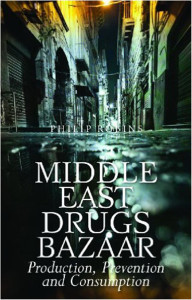
Middle East Drugs Bazaar: Production, Prevention and Consumption
Philip Robins
Hurst (paperback), 2016
PRs 3595
The Middle East is intimately involved in the issue of illegal drugs, which affects all the countries of the region: as a cultivator (Morocco, Lebanon); transit hub (Iran, Turkey); and consumer (Egypt). Yet, until now, there has been precious little research on any of these issues, especially in a comparative manner. This book, the first in any language to focus on illicit drugs in the Middle East, will surprise many readers. The consumption of qat in Yemen or cultivation of cannabis in Lebanon’s Bekaa Valley is hardly news, but the extent of amphetamine use in Saudi Arabia and the Gulf States or the international role of Israeli narcotics manufactures and traffickers is less well known.
Based on extensive research and interaction with law enforcement agencies, the public and private health sectors, drug-centric NGOs, and recovering drug abusers, Middle East Drugs Bazaar focuses on ten of the leading countries of the region, straddling the Arab World, Israel, Iran and Turkey. It tells the story of drug-related experiences where they most impinge on the peoples and societies of the region.
In addition to the social role of illegal drugs, their political and economic impact are also covered, including: war and drugs in Iraq; drugs and development in Yemen; and youth policy and drugs in Saudi Arabia.

